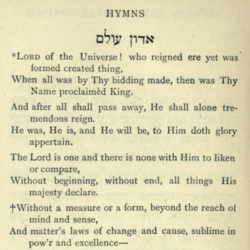| Source (Hebrew) | Translation (Spanish) |
|---|---|
אֲדוֹן עוֹלָם אֲשֶׁר מָלַךְ בְּטֶֽרֶם כׇּל־יְצִיר נִבְרָא׃ לְעֵת נַֽעֲשָׂה כְּחֶפְצוֹ כֹּל אֲזַי מֶֽלֶךְ שְׁמוֹ נִקְרָא׃ |
El Señor del Mundo Reynò, antes que todos los formados fuessen criados. Quando se hizo todo conforme a su voluntad, entonces se llamò Rey. |
וְאַֽחֲרֵי כִּכְלּוֹת הַכֹּל לְבַדּוֹ יִמְלֹךְ נוֹרָא׃ וְהוּא הָיָה וְהוּא הֹוֶה וְהוּא יִֽהְיֶה בְּתִפְאֲרָה׃ |
Y despues que todo se acabàre, el solo reynarà maravilloso. El existiò, el existe, y èl existirà con gloria. |
וְהוּא אֶחָד וְאֵין שֵׁנִי לְהַמְשִׁיל לוֹ לְהַחְבִּירָה׃ בְּלִי רֵאשִׁית בְּלִי תַּכְלִית וְלוֹ הָעֹז וְהַמִּשְׂרָה׃ |
El es uno, sin segundo, que se le pueda comparar o igualar. No tiene principio, ni tiene fin; a el solo compete el poder, y el mando. |
בְּלִי עֵֽרֶךְ בְּלִי דִמְיוֹן בְּלִי שִׁנּוּי וְהַתְּמוּרָה׃ בְּלִי חִבּוּר בְּלִי פֵרוּד גְּדׇל־כֹּחַ וְהַגְּבוּרָה׃ |
No tiene comparacion, no tiene semejanza, no se puede mudar, ni trocar. No padece ajuntamiento ni division, es la suma fuerza, y el valor. |
וְהוּא אֵלִי וְחַי גּֽוֹאֲלִי וְצוּר חֶבְלִי בְּיוֹם צָרָה׃ וְהוּא נִסִּי וּמָנוֹס לִי מְנָת כּוֹסִי בְּיוֹם אֶקְרָא׃ |
Este es mi Dios, y mi vivo Redemptor, y el fuerte de mi parte, en dia de Angustia. El es mi Pendon, y mi abrigo, mi esperanza quando le llàmo. |
בְּיָדוֹ אַפְקִיד רוּחִי בְּעֵת אִישַׁן וְאָעִֽירָה׃ וְעִם רוּחִי גְּוִיָּתִי אֲדֹנָי לִי וְלֹא אִירָא׃ |
En su mano deposìto mi espiritu, quando duermo, y quando estoy dispierto. Y con mi Espiritu le deposìto mi cuerpo, siendo Dios por mi, no tengo que temer. |
Ḥakham Ishak Nieto’s translation of Adon Olam was first printed on page 197 of Orden de las Oraciones de Ros-ashanah y Kipur (1740), his maḥzor in Spanish translation for Rosh haShanah and Yom Kippur. The Hebrew text of the piyyut set side-by-side with the translation was transcribed from Rabbi David de Sola Pool’s Tefilot l’Rosh haShanah (1937).
Adon Olam is a piyyut that became popular in the 15th century and is often attributed to Solomon ibn Gabirol (1021–1058) and less often to Sherira Gaon (900-1001), or his son, Hai ben Sherira Gaon (939-1038). The variation of the piyyut appearing here is the 12 line version familiar to Sepharadi congregations. (There are also fifteen and sixteen line variants found in Sepharadi siddurim. The Ashkenazi version has ten lines.)
Source(s)


“אֲדוֹן עוֹלָם (מנהג הספרדים) | Adōn Olam, translation by Ḥakham Ishak Nieto (1740)” is shared through the Open Siddur Project with a Creative Commons Public Domain Dedication 1.0 Universal license.









Leave a Reply